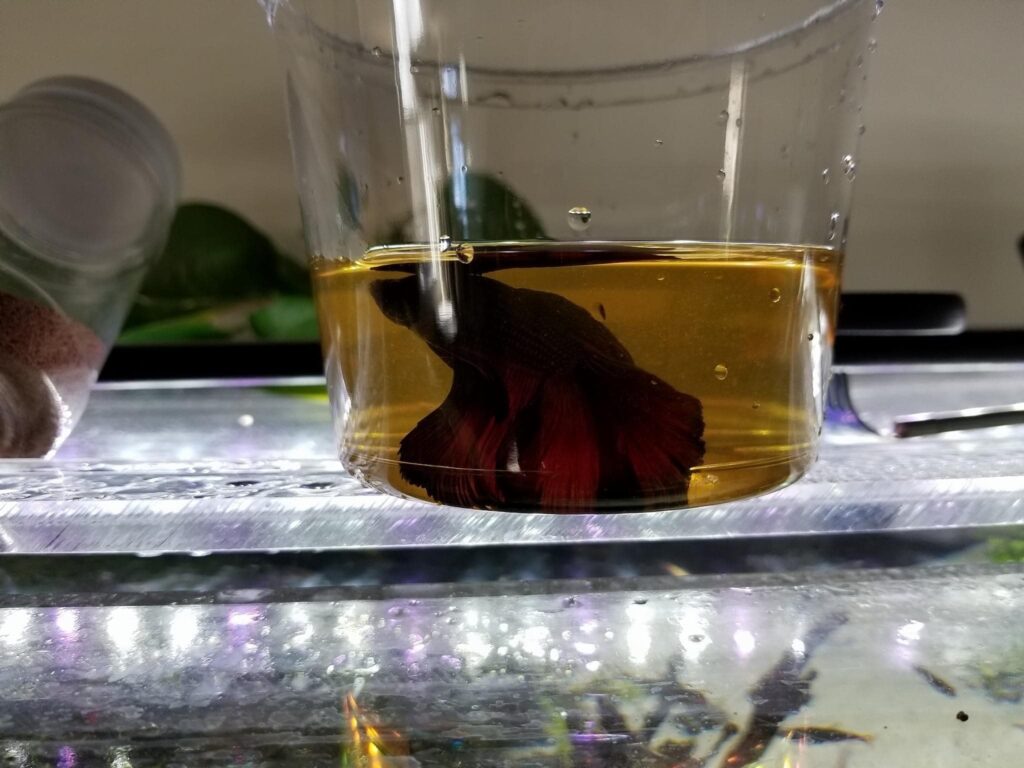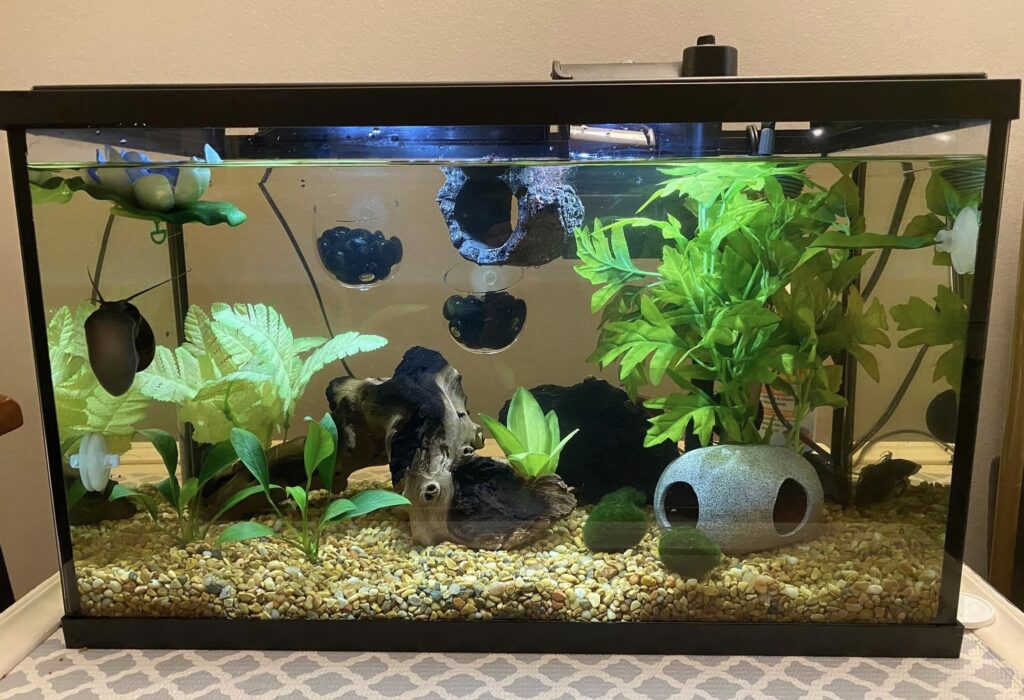It’s common for new Betta fish to experience stress and even die shortly after being introduced to a new tank with different water conditions and environments. This change can be too drastic for them, and they might find it difficult to cope. Therefore, aquarists are advised to acclimate their fish before exposing them to new conditions.
In this guide, I’ll explain different methods for Betta fish acclimation and expert tips to help you successfully transfer your fish from the bag or cup to the new environment.
What is Acclimation?
Acclimation is the process of allowing your fish or other living things to adjust to new environments or conditions.
All living creatures need time to adjust and slowly adapt to their new environment. That is why adaptation is one of the critical characteristics of living things.
Why Acclimating Your Betta Fish is Important?
By acclimating Bettas fish before introducing them to new tank conditions, you can help them adapt and thrive in their new home for a long time. Without proper acclimation, introducing the Betta fish to the new environment can send them into shock, mostly due to the sudden changes in pH level and water temperature (1).
The Science Behind
When a fish is placed in a sealed, small, “non-breathable” bag/cup, ammonia can build up quickly, especially during transport lasting longer than 4-6 hours. Bettas coming from overseas may endure several days in the bag.

Good breeders typically don’t feed fish for about two days before bagging. This reduces the chance of poop contributing to ammonia production and helps to reduce stress with food inside the stomach during transport.
During transport or while in a bag/cup, fish respiration produces carbon dioxide, which can lower the pH to below 6.5. At this point, harmful ammonia (NH3, NO2−) is converted to harmless ammonium (NH₄⁺). This is why fish tend not to experience ammonia burn or ammonia poisoning during transport.
However, when the bag is opened, air rushes in while carbon dioxide escapes, causing the pH to rapidly rise above 6.5 and the harmless ammonium to convert back to harmful ammonia. Ammonia burns the fish’s skin and irritates its gills.
When carbon dioxide escapes, the pH also rises, but the increase is probably not significant (around 7.2 or so). However, the concern is introducing a Betta to water in our tank that may have a much higher or lower pH. Some of us live in areas with tap or well water that has a pH ranging from 6.0 all the way up to 8.5. Subjecting a Betta to such a large pH difference suddenly, especially when the KH (carbonate hardness) is low, as well as GH (general hardness), can shock the fish and, in some cases, a difference of 1 can even be fatal.
Another factor to consider is the difference in water temperature between the bag/cup and the tank. A temperature difference of more than 2-3°F can shock fish.
Therefore, it’s important to take measures to mitigate all three of these factors: ammonia, pH, and temperature difference.
Betta Acclimation Scenarios
The acclimation process of new fish must begin immediately upon arriving home. A slow, careful acclimatization process will give your new pet the best chance for survival in your tank.
There could be several different scenarios for acclimatizing a new fish, including:
Acclimating to a Community Aquarium
If you have an extra tank, you should quarantine and acclimate new fish for at least two weeks, especially when you want to introduce them to a community tank. It’s essential to observe the general behavior of the fish and signs of illness or disease. This helps to prevent the spread of diseases or parasitic infections that can affect other fish in the community tank.
Acclimating to a New Aquarium
If you haven’t set up your Betta fish tank yet, you’ll have to do it as soon as possible. You’ll have to provide filtration, heating, and decorations for the fish following the safety measures. Once the tank is set up and properly cycled, you can then acclimate the Betta fish to the new environment. Remember to monitor the water parameters regularly and make adjustments as necessary to ensure the health and well-being of your Betta fish.

Acclimating to a Cycled Tank
If your aquarium is set up already and cycled properly, you’re all set to move to the next step of Betta acclimation.
Preparing for Acclimation
Gather the necessary materials:
- Water conditioner / Seachem Prime
- API Freshwater Master Test Kit to monitor pH, ammonia, nitrate, and nitrite levels
- Hose or medicine dropper
- Clips to hold the bag in place and for the hose
- A clean, sterilized container or bucket
- A thermometer to monitor water temperature
- A net to catch your Betta fish
- A timer or watch to monitor the acclimation time
Assuming that the fish had traveled in a sealed bag/cup for more than 4 hours, Don’t open the bag/cup – leave it as it’s and have everything ready for acclimatization. Keep the bag/cup in a dark and warm place in the meantime.
You need to know your tank and bag’s water pH and temperature. This will likely dictate the chosen path between the pH or temperature acclimation.
Methods for Acclimating Your Betta Fish
The most common methods of Betta acclimation include the floating bag (plop and drop) and the drip acclimation method. Let’s explore these methods and why they might be used.
The Float Method
This method is typically used when you have been to a local fish store and are simply transporting the fish from one destination to another.
You can follow a few necessary steps for temperature acclimation:
- Leave the bag unopened and let it float in the tank for at least 30 minutes.
- Check the temperature of the bag water and the tank water. Wait until the temperature has equalized.
- Open the bag and add 1 drop of Seachem Prime to bind the harmful ammonia.
- Test the pH level of the tank water. If it’s around 7.0, you can pour out as much bag water as possible.
- Let the Betta fish swim out of the bag into the tank.
Here are the steps for pH acclimation:
- If the tank water pH is significantly higher or lower than the bag water pH, remove some bag water and add some tank water to the bag.
- Let the bag sit for 30 minutes before repeating the process 3-4 more times. To make it easier, you can put the bag inside a clean plastic cup and remove the cup water and add new water.
- The larger the pH difference, the smaller the amount you should swap, and the more times you should repeat the process.
- Add 1 drop of Seachem Prime into the bag immediately after opening it, which allows you to acclimate your Betta based on the pH situation.
Note that drip acclimation is also a good method for pH acclimation.
The Drip Method
Here’s the step-by-step method for drip acclimation:
- Float the bag or cup in the tank where you plan to keep the fish for at least 20 minutes.
- While the bag is floating, gather your essentials, including a water conditioner, a hose or medicine dropper, a clip to hold the bag in place, and one for the hose, and a bucket to transfer the fish to.
- Carefully cut the top of the bag, hold it straight up, and add a drop of Seachem Prime. Place one end of the hose into the tank and suck on the other end until the water is halfway through the hose, then let the water run back into the tank until you have a decent stream.
- Clip the hose and adjust the flow to only a few drops per second or less.
- Once the hose is set up correctly, place it into the bucket or bag and watch the fish closely. If you notice a sudden, drastic change in behavior, clamp the hose tighter and reduce the drops per second. If the fish look fine, continue acclimating them for at least 30 minutes to an hour.
There’s another way to do this:
- Cut the bag open after letting it float. Add a drop of Seachem Prime. Grab a medicine dropper and do 5 drops every 5-6 seconds. Watch the fish and slowly increase the drops each time. If they are handling it well, continue until you have at least a quarter of the bag filled with your tank water.
- Grab your net and gently tip the bag or cup over into the net, into a bucket or container until you catch the fish. Then add it immediately into the tank and dump the water from the bag outside. If you prefer to net the fish the regular way, that’s fine as well.
Watch your new friend enjoy and explore their new home! If you notice any struggling happening, turn the lights off. Rapid breathing can still happen after acclimating due to the netting.
I have personally never lost a fish or Shrimp doing either of these acclimating processes for years now.
Frequently Asked Questions about Betta Acclimation
Does moving to a new house require acclimation for your Betta fish?
Yes, moving to a new house requires acclimation for your Betta fish. When moving, it’s important to test both sources of water (old house and new house) to determine the proper method of acclimation to use when adding your fish back to their tank in the new source of water. If you’re moving a short distance and the water source is the same as your old house, then temperature acclimation should be sufficient.
Does moving fish from one tank to other require acclimation?
No, moving fish from one tank to another within your home doesn’t require acclimation. This is because the pH and temperature in both tanks should already match as the same source of water is used for both tanks.
Conclusion
Acclimating isn’t a complicated, or challenging process. No matter which acclimation method you use for Betta fish, taking time to gradually adjust the fish to its new surroundings will significantly reduce its stress levels and prevent the risk of disease and infection.
Remember to keep an eye on your fish regularly and make necessary adjustments to maintain a healthy and thriving environment for your Betta. With the right acclimation techniques and care, you can enjoy a beautiful and vibrant Betta fish for years to come.